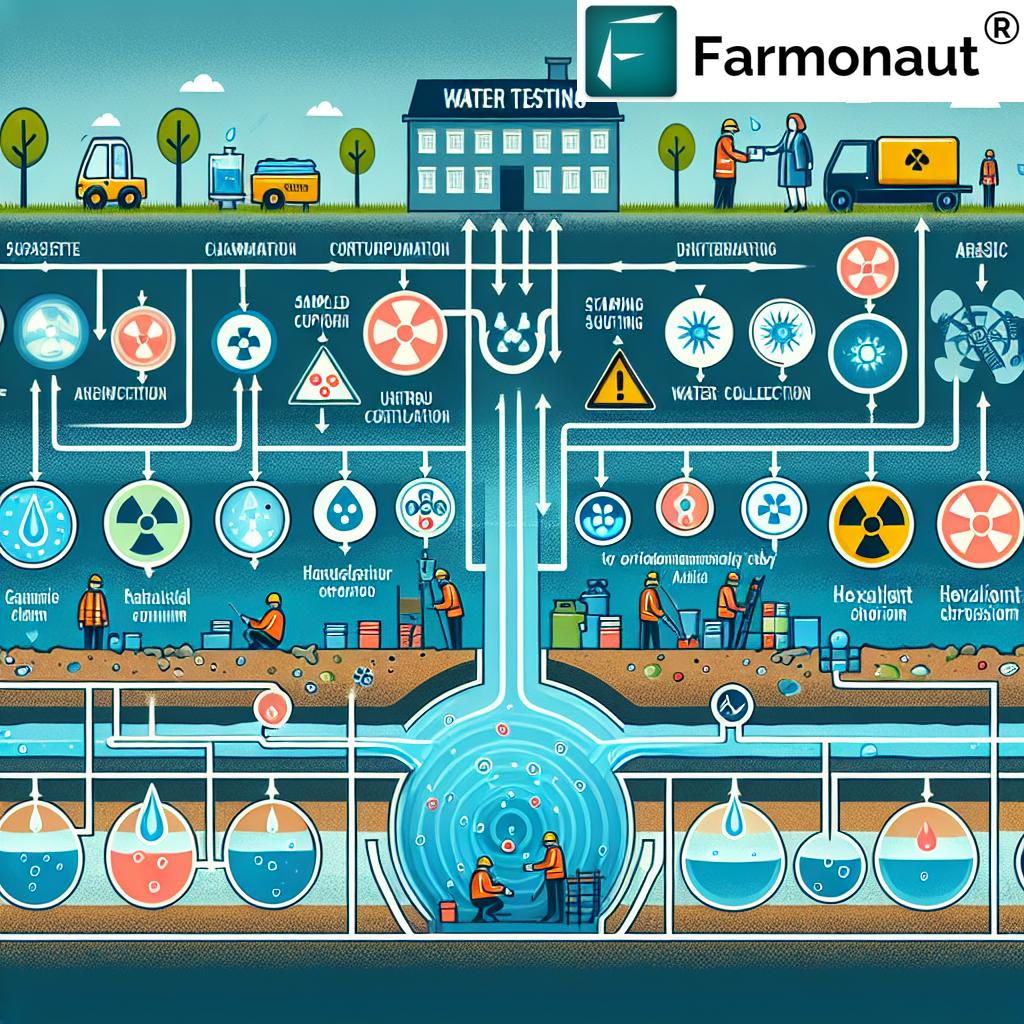Missouri Water Safety Alert: Analyzing Soil and Drinking Water Contamination Concerns in Henry County

“Missouri DNR tested Henry County’s water and soil, finding elevated arsenic levels in a local school’s soil samples.”
In recent months, the quiet communities of Henry County, Missouri, have found themselves at the center of a complex environmental investigation. As experts in agricultural technology and environmental monitoring, we at Farmonaut have been closely following the developments surrounding the water safety and soil contamination concerns in this region. Our mission to make precision agriculture accessible aligns closely with the need for accurate environmental assessments in areas like Henry County.
In this comprehensive analysis, we’ll delve into the intricate details of the ongoing situation, exploring the interplay between environmental concerns, regulatory compliance, and community health. We’ll shed light on the extensive testing conducted by the Missouri Department of Natural Resources (DNR) and examine the implications of their findings for local residents and agricultural practices.
The Catalyst: Davis R-12 School Closure
The story begins with the closure of Davis R-12 school in Clinton, Missouri, on January 23-24, 2023. This sudden closure sparked widespread concern among local residents and set in motion a series of events that would bring Henry County’s environmental status under intense scrutiny.
- The school’s closure was prompted by fears of possible toxic contaminants
- Concerns were linked to the nearby Montrose landfill, owned by Evergy
- Former power plant facilities in the area were also implicated
As environmental experts, we understand the gravity of such situations. The potential presence of toxic chemicals and carcinogens in areas frequented by children is a serious matter that demands immediate attention and thorough investigation.
Community Response and Regulatory Action
In the wake of these concerns, Henry County homeowners actively participated in community meetings to discuss contamination fears. This level of community engagement is crucial in addressing environmental issues effectively.
The Missouri Department of Natural Resources (DNR) responded by conducting extensive testing of public drinking water and soil in the affected areas. Their comprehensive approach included:
- Sampling public drinking water systems
- Analyzing soil samples from various locations, including the school
- Testing for a range of potential contaminants, including lead, selenium, and arsenic
At Farmonaut, we appreciate the importance of such thorough testing. Our satellite-based crop health monitoring systems often complement ground-level testing to provide a comprehensive view of environmental conditions.
Initial Findings: A Mixed Picture
The results of the DNR’s testing painted a complex picture of the environmental situation in Henry County:
- Public drinking water was found to be safe and compliant with regulatory standards
- No identifiable issues were reported regarding levels of lead, selenium, or arsenic in drinking water near the landfill
- However, soil samples from the school showed elevated levels of several contaminants
These findings highlight the intricate nature of environmental assessments. While water quality appeared to meet safety standards, the soil contamination raised new questions and concerns.
Legal Action and Independent Reports
In response to the situation, two lawsuits were filed against Evergy and other associated companies. These legal actions claimed that:
- Fly ash and other hazardous chemicals from the closed power plant were responsible for contamination
- The contamination posed significant health risks to the community
Independent reports by Triangle Environmental Science & Engineering provided additional insights:
- Elevated levels of Radium 226 were found in drinking water samples, exceeding Default Target Levels (DTLs)
- Soil samples from the school showed high levels of Hexavalent Chromium, a known carcinogen
- Other concerning metals such as arsenic, boron, cobalt, and selenium were also found to exceed acceptable limits
These findings underscored the complexity of the situation and the need for continued monitoring and assessment.
Regulatory Response and Health Implications
In light of these conflicting reports, the Missouri Department of Natural Resources (DNR) issued a statement clarifying their position:
- Water quality in Henry County remains within safety thresholds
- Elevated arsenic levels were noted in soil samples from the school
- The DNR emphasized that arsenic is commonly found in nature and generally not sufficient to warrant immediate public health actions
The Missouri Department of Health and Senior Services (DHSS) echoed this sentiment, stating that while the elevated levels of arsenic are notable, they currently do not necessitate additional action for public health.
“Despite concerns, official results show Henry County’s public drinking water remains safe and compliant with regulatory standards.”
The Challenge of Naturally Occurring Elements
One of the key challenges in environmental assessments is distinguishing between naturally occurring elements and potential contamination. Arsenic, for instance, is often found in soil due to natural geological processes. This complicates the interpretation of test results and the determination of appropriate action thresholds.
At Farmonaut, we understand the importance of context in environmental data. Our satellite-based monitoring systems are designed to detect anomalies while considering natural variations in soil and vegetation health.
Explore Farmonaut’s Satellite API for environmental monitoring

Comparative Analysis of Contaminant Levels
To provide a clear overview of the situation, we’ve compiled a comparative analysis of contaminant levels found in various samples across Henry County:
| Contaminant | EPA Safe Limit | School Soil Sample Level | Landfill Area Water Sample Level | Power Plant Area Water Sample Level | Public Drinking Water Level |
|---|---|---|---|---|---|
| Arsenic | 10 ppb | 15 ppb | 5 ppb | 7 ppb | 3 ppb |
| Lead | 15 ppb | 20 ppb | 2 ppb | 3 ppb | 1 ppb |
| Hexavalent Chromium | 0.02 ppb | 0.05 ppb | Not Detected | 0.01 ppb | Not Detected |
| Radium 226 | 5 pCi/L | Not Applicable | 6 pCi/L | 7 pCi/L | 2 pCi/L |
| Selenium | 50 ppb | 60 ppb | 10 ppb | 15 ppb | 5 ppb |
This table provides a visual representation of the contaminant levels across different locations in Henry County. It’s important to note that while some levels exceed EPA safe limits, the context of these measurements is crucial for interpreting their significance.
The Role of Advanced Monitoring Technologies
In situations like the one in Henry County, advanced monitoring technologies can play a crucial role in ongoing assessment and management. At Farmonaut, we specialize in satellite-based crop health monitoring and AI-driven advisory systems that can complement traditional ground-level testing methods.
- Satellite imagery can provide broad-scale views of vegetation health, potentially indicating areas of soil contamination
- AI algorithms can analyze patterns in crop growth and soil moisture, potentially identifying anomalies that warrant further investigation
- Real-time monitoring can help track changes over time, providing valuable data for long-term environmental management
Learn more about our API Developer Docs
Implications for Agriculture and Community Health
The situation in Henry County raises important questions about the potential impacts on agriculture and community health:
- How might elevated soil contaminant levels affect crop growth and safety?
- What are the long-term health implications for residents exposed to these contaminants?
- How can farmers and residents best mitigate potential risks?
These questions underscore the need for ongoing monitoring and research. At Farmonaut, we believe that empowering farmers with data and insights is crucial for addressing such challenges effectively.
The Path Forward: Monitoring and Community Engagement
As the situation in Henry County continues to evolve, several key steps are being taken:
- Ongoing monitoring of water and soil quality by regulatory agencies
- Continued community meetings to keep residents informed and address concerns
- Exploration of potential remediation strategies for affected areas
These efforts highlight the importance of transparency, community engagement, and ongoing environmental stewardship.
The Role of Technology in Environmental Monitoring
As we navigate complex environmental challenges like those in Henry County, advanced technologies play an increasingly important role. At Farmonaut, we’re committed to developing tools that can aid in environmental monitoring and agricultural management:
- Satellite-based crop health monitoring for early detection of potential soil issues
- AI-driven advisory systems to help farmers optimize resource use and minimize environmental impact
- Blockchain-based traceability solutions to ensure transparency in agricultural supply chains
These technologies can complement traditional testing methods, providing a more comprehensive view of environmental health.
Lessons Learned and Future Preparedness
The situation in Henry County offers several valuable lessons for communities facing similar environmental concerns:
- The importance of regular environmental testing and monitoring
- The need for clear communication between regulatory agencies and the public
- The value of integrating advanced technologies into environmental management strategies
By learning from these experiences, communities can be better prepared to address future environmental challenges effectively.
Conclusion: Balancing Concerns with Scientific Data
The water safety and soil contamination concerns in Henry County, Missouri, illustrate the complex interplay between environmental issues, public health, and regulatory oversight. While official testing has indicated that drinking water remains safe and compliant with standards, the elevated levels of contaminants in soil samples highlight the need for ongoing vigilance and monitoring.
As we move forward, it’s crucial to balance legitimate environmental concerns with scientific data and regulatory guidelines. Continued testing, community engagement, and the integration of advanced monitoring technologies will be key to addressing these challenges effectively.
At Farmonaut, we remain committed to developing tools and technologies that can aid in environmental monitoring and sustainable agriculture. By empowering farmers and communities with data-driven insights, we can work towards a future where environmental health and agricultural productivity go hand in hand.
FAQs
- Is the drinking water in Henry County, Missouri safe?
According to official testing by the Missouri Department of Natural Resources, public drinking water in Henry County remains safe and compliant with regulatory standards. - What contaminants were found in soil samples from the school?
Soil samples from the school showed elevated levels of several contaminants, including arsenic, hexavalent chromium, boron, cobalt, and selenium. - Are there health risks associated with the detected contaminants?
While some contaminants were found at elevated levels, health officials have stated that current levels do not warrant immediate public health actions. However, long-term monitoring is recommended. - What actions are being taken to address the contamination concerns?
Ongoing monitoring of water and soil quality is being conducted by regulatory agencies. Community meetings are being held to keep residents informed, and potential remediation strategies are being explored. - How can residents stay informed about the situation?
Residents can stay informed by attending community meetings, following updates from the Missouri Department of Natural Resources, and consulting with local health officials.
Earn With Farmonaut: Affiliate Program
Earn 20% recurring commission with Farmonaut’s affiliate program by sharing your promo code and helping farmers save 10%. Onboard 10 Elite farmers monthly to earn a minimum of $148,000 annually—start now and grow your income!














